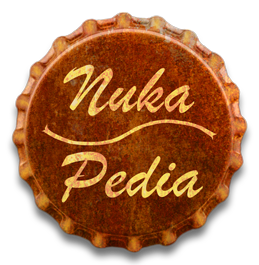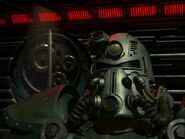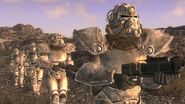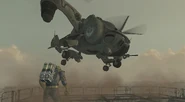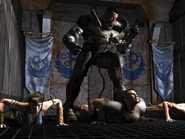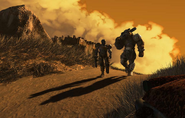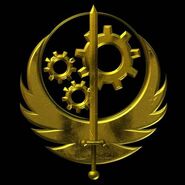Fallout Faction Overhaul Project
This article is within the scope of the Fallout Faction Overhaul Project. This project is dedicated to organizing and improving the quality of the various faction pages. For participation, please check the project page.
|
| For the location titled "Brotherhood" in Fallout, see Lost Hills. |
The Brotherhood of Steel (BoS) is a quasi-religious organization operating across the ruins of post-war North America, with its roots stemming from the American military and the government-sponsored scientific community from before the Great War.
Background
Origins
The founder of the Brotherhood of Steel was Captain Roger Maxson of the United States Army. He was a member of a military team commanded by Colonel Robert Spindel, originally sent to the West-Tek research facility on January 3, 2076 by the U.S. Army to monitor the experiments being conducted there by West-Tek on behalf of the American government in the interest of national security. On January 7, 2077, all West-Tek military research was moved to the newly-constructed Mariposa Military Base, along with Spindel's team, to enhance the research's security.
On October 10, 2077 Captain Maxson and his men discovered, to their horror, that the West-Tek scientists at Mariposa were using military prisoners as involuntary test subjects in their experiments with the genetically-engineered Forced Evolutionary Virus. Morale in the base broke down, and Colonel Spindel suffered a mental breakdown, eventually committing suicide five days later. Captain Maxson's men turned to him for leadership in the midst of the crisis.
After interrogating Robert Anderson, the chief scientist on the West-Tek research team, and learning about the extent of their scientific experiments on military prisoners, Maxson executed Anderson and many of the other scientists. Maxson, now in control of Mariposa, declared himself to be in full desertion from the U.S. Army via radio on October 20, 2077. Strangely, he got no response from the Army chain-of-command, as the rest of the Army was too busy fighting the Chinese threat. Three days later, on October 23, 2077, the nuclear arsenals of both sides were launched, and the Great War ended two hours after it started, with most of the Earth reduced to a radioactive wasteland.
The Mariposa Military Base survived the nuclear exchange that devastated the United States, the soldiers within protected from the radiation and FEV flooding into the newly created Wasteland by the base's highly-effective nuclear, biological and chemical weapons protection protocols. Two days later at Mariposa, on October 25, 2077, an Army scout in power armor named Platner was sent out to get specific readings on the atmosphere. He reported no significant amounts of radiation in the area surrounding the facility. After burying the bodies of the executed scientists in the wastes outside of Mariposa the soldiers sealed the military base, then headed out into the desert, taking supplies and weapon schematics from the base with them. Captain Maxson led his men and their families to the government fallout bunker at Lost Hills in California ("the Exodus"). In November 2077, after a few weeks in the Wasteland, the soldiers and their families arrived at the Lost Hills bunker. However, they suffered many casualties along the way from the terrible conditions of the Wasteland, including Maxson's wife (but not his teenage son). The Lost Hills bunker became the headquarters of the newly formed paramilitary organization that Maxson created and named the Brotherhood of Steel, intending to use its resources to eventually rebuild human civilization—no matter the cost.
Early Years
Little is known about the early years of the Brotherhood of Steel. In 2134, a faction led by Sergeant Dennis Allen gained strength in the organization, and urged the Brotherhood's Elders to let them explore the southeast ruins of the primary West Tek Research Facility, now called the Glow after it was directly hit by a Chinese nuclear bomb, for technological artifacts. The Elders refused, so Sergeant Allen and his separatist faction split away from the Brotherhood of Steel, taking some advanced technology and weapons with them. Despite that, under the leadership of Roger Maxson, the Brotherhood grew in strength, further developing their technology, and the orders of Knights, Scribes, and Paladins were formed. In 2135, Roger Maxson died of cancer, and his son took over as the new High Elder of the Brotherhood.
In the 2150's, the Brotherhood established its control over the areas surrounding the Lost Hills bunker, becoming one of the major powers in the Core Region of the West Coast. Some time in the early 2150s a raider group known as the Vipers began to establish a power base in the badlands to the south of the Lost Hills Bunker. Driven by a religious frenzy (and the need to provide for their much larger numbers of soldiers and disciples), they began raiding more frequently than before, eventually attracting the attention of the Brotherhood of Steel.
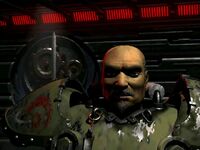
Rhombus
In 2155, the Brotherhood sent out a few squads of scouts to track the Vipers down. This was more of a training exercise conducted by the High Elder than anything else, as the Brotherhood was convinced that a small detachment of troops in power armor would be sufficient to deal with a group of raiders, no matter how large. One Brotherhood squad, led by High Elder Maxson, found the Vipers. Expecting the raiders to break and run at the sight of soldiers in power armor, Maxson did not take into account the religious zeal and ferocity of the Vipers...or their poisoned weapons. A single arrow nicked him while his helmet was off, causing him to die a few short hours later. John Maxson, the grandson of Roger, took up the role of High Elder, and Rhombus became the new head of the Paladins and the order of Knights.
The Paladins, now led by Rhombus, began a full scale campaign against the Vipers, tracking them down and wiping out almost all of their members within the span of a month. Some of the Vipers were able to flee north and east into the Sierra Nevada mountain range.
During the campaign, the Brotherhood sent a few scouts and emissaries to the Hub to track down the Vipers' members, and from these beginnings, the Hub and the Brotherhood opened full trade relations (caravans had delivered to the Brotherhood before, but not long after the destruction of the Vipers, caravan trains ran directly from the Hub to the Brotherhood's headquarters at Lost Hills on a regular basis).
The super mutants
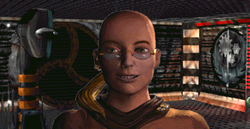
Scribe Vree
Several years later, the Brotherhood faced an enemy far greater than any band of raiders. In October of 2161, a Brotherhood of Steel patrol came across a dead super mutant in the badlands. They took the corpse back to the Scribes, and Head Scribe Vree began to study it. After several long examinations, it was shown to be completely sterile.
In 2162, the Vault Dweller arrived at the Brotherhood's base at Lost Hills, wanting to join them. He was not taken seriously and sent on the usual fool's errand to the ruins of the West Tek Research Facility, renamed "The Glow" after a Chinese nuclear attack during the Great War made the facility a radioactive death trap. He surprised everyone by not only returning alive, but also succeeding in his mission (he was tasked with finding a holodisk with the record of an expedition of several Brotherhood Paladins to the Glow). As a result, he was the first outsider in a very long time to be accepted as a member of the Brotherhood of Steel, even though some prominent members of the Brotherhood resisted his joining the organization.
It was from the Vault Dweller that the Brotherhood learned about the Master's mutant army and his plans to turn all human survivors into super mutants. With the support of High Elder John Maxson, the Vault Dweller managed to convince the Council of Elders to send a squad of Paladins to the Mariposa Base (which had been, ironically, where the Brotherhood originated, although not even Maxson was aware of that), where the Master's FEV vats were located. With the help of the Brotherhood, the Vault Dweller eventually managed to defeat the Master, and was never seen again in the Lost Hills bunker. The Brotherhood at this time appeared to be the most technologically advanced faction encountered in the Core Region of the West Coast. Although the super mutant army and the Gun Runners had access to comparable advanced weaponry, the Brotherhood had a monopoly on power armor, certain medical technologies like cybernetics, and advanced supercomputers.
Aftermath
Following the defeat of the Master, the members of the Brotherhood began disputing amongst themselves over the need for new recruits versus their secrecy as an organization. The Elders finally ruled against the sharing of technology with outsiders, believing that they would continue to survive on their traditional principles. The minority that was opposed to this was sent eastward to track down the remnants of the Master's army via airships. When these airships crashed near Chicago, this group founded a new contingent of the Brotherhood of Steel: the Midwestern Brotherhood of Steel. The Brotherhood would later establish small outposts throughout the California area, as well as carry out expeditions to Washington D.C. in 2254 and the Mojave later on.
Also following the defeat of the Master, the New California Republic was founded and began expanding. Eventually, the NCR founded the state of Maxson in the surrounding area of the Lost Hills Bunker. While the bunker remained under Brotherhood control, the state was under the jurisdiction of the NCR. Relations between the two factions weren't without tensions, but the two remained at peace for the time being.
The Enclave
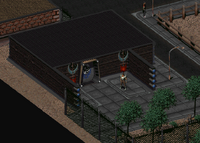
At the San Francisco outpost, Matt assigns an important task to the Chosen One
By 2242, the Brotherhood was no longer the power that they once were. With the reemergence of the Enclave, the Brotherhood was no longer the most advanced organization in the wasteland, and knowing this, the Brotherhood was intimidated. Without the proper resources to deal with the Enclave, the best the Brotherhood could do was keep an eye on them; to this end, several bunkers near areas of Enclave activity were reactivated.
Eventually, the Brotherhood learned of the Enclave's vertibird technology. Without similar technology of their own, the Brotherhood would be unable to counter a possible Enclave invasion. At the request of his superiors, Matt of the San Francisco bunker enlisted the help of the Chosen One in retrieving the vertibird plans from Navarro.
The Chosen One completed his mission successfully, but it is unknown whether or not these plans ever reached the High Council, as Matt was killed by Frank Horrigan a short time later. However, with the destruction of the Oil Rig and the NCR hunting down the surviving members, the Enclave ceased to be a threat (at least on the West Coast).
War with the NCR
| The following is based on Van Buren design documents and is not canon. |
By 2231, Jeremy Maxson had assumed the position of Brotherhood High Elder. In addition to wanting to expand Brotherhood operations eastward, he was much more aggressive in his "hoarding" of pre-War technology. He wanted to restore the power of the Brotherhood by wresting all advanced tech from the hands of "lesser people" by any means necessary. Naturally, this led to disputes with the NCR, which had always been in favor of using advanced technology for the benefit of society (at least according to Thomas Moore, an NCR citizen, which is what he saw as the NCR's justification for trying to annex Vault City). Shortly after the destruction of the Enclave, a war broke out between the Brotherhood and the NCR.
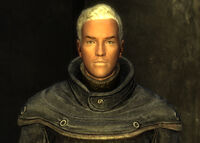
Elder McNamara in 2281
With their superior technology, the Brotherhood managed to hold out against the NCR, even coming close to total victory. Yet, the Brotherhood's technological advantage was eventually outdone by the sheer size of the NCR's army; no matter how many troops the NCR lost, they always seemed to have more. The Brotherhood, on the other hand, was still a selective group, and thus, was short on numbers. With this discrepancy in troop numbers, the Brotherhood's defeat was imminent.
| End of information based on Van Buren design documents |
The Mojave chapter of the Brotherhood of Steel would still be fighting the NCR as late as 2274. After establishing a base at HELIOS One, the Mojave Brotherhood soon found themselves at odds with the NCR and its growing power in the region. Eventually, the NCR sought to control HELIOS One, and the Brotherhood, under the orders of their Elder, Elijah, refused to leave. This led to a confrontation between the two, and in the typical chain of events, the Brotherhood's superior technology was no match for the NCR's superior numbers, and they were defeated in one of the bloodiest battles in the Brotherhood's history. With over half of the chapter dead, the Brotherhood retreated to the Hidden Valley bunker where Nolan McNamara (in light of Elijah's disappearance following the battle) took the role of Elder upon himself and placed the bunker under lock-down. Since then, the Brotherhood's presence in the Mojave Wasteland has been confined to only a few scouting missions, a great point of controversy amongst the chapter.
Society
The Brotherhood of Steel is a neo-knightly order that rose from the ashes of the American military of the West Coast in the years following the devastation of 2077. The organization's tenets include the eradication of mutants and worship of technology, and the Brotherhood has never been very keen on sharing their resources with their fellow wastelanders (who they generally consider too ignorant and irresponsible to deserve such advanced technology).
The Brotherhood is generally beneficial to humanity, but they have their faults: They don't care for mutants; they worship technology (and in many cases put it above human life); and they don't like to share their choicest technological discoveries, despite the obvious benefits their technology could bring to the Wasteland. It's commonly accepted within the Brotherhood that the people of the Wasteland are not responsible enough to use (and maintain) all of the technology the BoS has at their disposal. They are known for trading some of their technologies with frontier communities and NCR states, but they keep the more sensitive technologies to themselves.
Ideology
Although the Brotherhood has always been portrayed as aloof, as time went on more negative aspects of their beliefs have been increasingly emphasized as their power has decreased. Originally they stood for relatively benign goals of preservation. Indeed, in one of the possible endings in Fallout; they voluntarily reintroduce technology, engage in novel research, and actively help the wasteland. Later, in Fallout Tactics, the Midwestern faction eventually would go on to become a near-fascist state, but only if a specific ending is chosen in which this faction assumes the new leadership of a prejudiced General Barnaky. A different ending involves the Midwestern Brotherhood working together with the humans and non-humans of the Midwestern wasteland for the greater good, and create a post-apocalyptic utopia. (However, it should be noted that none of the endings of Fallout Tactics has yet been assumed as canon, and so is open to speculation.) By the time of Van Buren/New Vegas the main Brotherhood is strongly paranoid, not only seeks to preserve technology but actively remove it from outsiders, is disinterested in nonmilitary assets, and engages in little if any work to actually improve their tech. Much of the Brotherhood's belief system is enshrined in a document known as the Codex, which acts as an important source of information on regulations and rules that members must adhere to. The East Coast Brotherhood is different from the West Coast, seeming to want to help others instead of collect vital technology, but this created a faction focused entirely on collecting tech in the east, the Brotherhood of Steel Outcasts.
Symbolism of the insignia
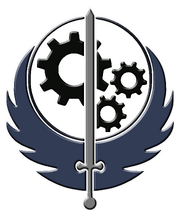
Brotherhood of Steel insignia
In the Brotherhood symbol, the gears represent their engineering knowledge, the sword is their will to defend themselves, the wings represent the uplifting hope that the acquisition of lost technology represents for mankind's salvation following the devastation of the Great War, and the circle represents the fraternal unity that makes the organization a true brotherhood.[1]
Another interpretation is that the Brotherhood's symbol represents each of the organizations different orders. The sword represents the Paladins, the wings represent the Elders (the "wings" control the movement of the sword), the large gear represents the Knights, and the two smaller gears represent the Scribes and the Initiates, whose services keep the Knights supplied with the information and the manpower required to get their jobs done.[2]
| The following is based on information from Fallout Tactics. |
While both the original Brotherhood of Steel in the Core Region and the Capital Wasteland faction of the Brotherhood use different colors for different elements of the symbol (blue for the wings, gray for the sword and black for the gears), the Midwestern Brotherhood uses several mono color variations. A blue version is used by the Midwestern Brotherhood's Knights and Paladins, a black one by the Scribes and an orange one by the Elders. The golden/yellow variant seems to symbolize the Midwestern Brotherhood as a whole. The Midwestern version of the Brotherhood symbol is also reversed horizontally - the large gear is to the right of the smaller ones, not to the left as in the original.
| End of information based on information from Fallout Tactics |
Structure
The Brotherhood is mostly composed of the descendants of those military officers, soldiers, and scientists, but aside from some outsiders among their ranks, the Brotherhood is as close to pure-strain humanity (prime normals) that may be found outside of a Vault or the Enclave.
The ranks of the Brotherhood of Steel are generally recognized as being composed of the best and the brightest remaining to humanity, which means the BoS is a relatively small organization, at least compared to the New California Republic. They make up for this with their frightening arsenal of pre-and-post-Great War technology: they have laser weapons, power armor, surgical cybernetic enhancements, combat implants, and Brotherhood Paladins have the ability to erase an entire town from the map without a scratch. The vast majority of BoS members are born into the Brotherhood - they very rarely accept outsiders into their ranks. While not an official policy, many members believe that in order to survive, all members are obligated to procreate. This results in a lack of tolerance for same-sex relationships, at least when the proponents of the aforementioned stance are concerned. Those born in the Brotherhood that want to be neither Scribes, Knights nor Paladins are free to leave - the Brotherhood does not believe in forcing anyone to serve them against their will. Although, members who decide to leave the Brotherhood will face the punishment of death for sharing any medical or scientific knowledge they have acquired with any outside faction.
While they have great reverence for technology, most of the Brotherhood members have little regard for non-technical fields of knowledge (and even for non-combat-related technology). Even most of the Scribes do not care about history, and some Brotherhood of Steel Initiates do not even know who Roger Maxson, the founder of the Brotherhood, was.
Divisions and locations
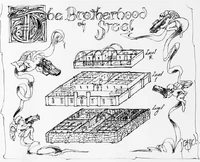
Concept art of the Lost Hills bunker.
The headquarters of the Brotherhood is the Lost Hills bunker in California, the seat of the Brotherhood's High Elder and its ruling council, and the place where the organization was founded. It is also the center of their research and military activities. However, by 2242, the Brotherhood was spread across the wastes of California in small bunkers and installations hidden from the eyes of common folk, and finding them all and wiping them out would be a difficult and dangerous task.
Their installations include bunkers in the Den, San Francisco, and Shady Sands (capital of the New California Republic). All Brotherhood outposts are formally subject to the Lost Hills' ruling council's authority, even if they sometimes tend to act independently, especially if they are located far from California and contact with the headquarters is rare. The Lost Hills bunker is surrounded by the town of Maxson, which, while named after the founder of the Brotherhood, is officially outside Brotherhood rule and is a state of the New California Republic. The later conflict between the Republic and the Brotherhood most likely resulted in the destruction of many of the Brotherhood's bunkers in the Core Region.
A Brotherhood bunker is located in the Hidden Valley, directly east of the settlement of Goodsprings in the Mojave Wasteland. It is surrounded by powerful underground fans that serve as a high-tech defense system, creating artificial sandstorms which allow the inhabitants to travel to and from the bunker under cover. It also serves as a kind of electronic disturbance to any and all outside factions' targeting sensors, therefore rendering the bunker safe from detection. Mr. House's calculations painted the Brotherhood insurgency to be the greatest threat to House's reign in the Mojave Wasteland in the long-term.
East Coast Brotherhood
The Citadel
On the East Coast, the Capital Wasteland division of the Brotherhood established a base called the Citadel, built into and beneath the ruins of the Pentagon in Washington, D.C. This faction is led by the idealistic Elder Owyn Lyons who decided to make the protection of the human inhabitants of the Capital Wasteland from super mutants and other threats his top priority, instead of the acquisition and preservation of technology. While Lyons is officially recognized by the ruling council at Lost Hills as the leader of a Brotherhood faction, because of his changed priorities he receives no support from California and his faction, for all intents and purposes, is independent. Without reinforcements from the West Coast, Lyons has been forced to recruit locally, but most new wastelander conscripts are overeager, unskilled, or both, and as a result their survival rate is atrocious. Elder Lyons’ daughter Sarah commands her own elite squad, Lyons' Pride. These soldiers help preserve the Capital Wasteland by holding back the super mutants, who tend to remain in the urban ruins of Washington, D.C.
As the war with the super mutants intensifies, an East Coast faction of the Enclave, whose broadcasts have been heard for years on wasteland radios, suddenly and violently makes themselves known. In an opening move they seize the Jefferson Memorial's "Project Purity", and then begin a systematic purge of any and all mutated life in the Capital Wasteland. At first favoring caution, Elder Lyons is soon forced to engage the Enclave in a full-scale battle when the Enclave takes control of Vault 87's G.E.C.K. and comes dangerously close to activating "Project Purity". With the aid of the Lone Wanderer, and Liberty Prime, the Enclave is ousted from the Jefferson Memorial and thrown into disarray. After the events of Broken Steel, and the defeat of the Enclave remnants, the Capital Wasteland chapter has become as powerful and well-equipped as their sister chapters back west.
There are members of Lyons' expeditionary force to the East Coast who preferred to stay faithful to the Brotherhood's original goals of locating and preserving technology and knowledge. These members of the Brotherhood left the Citadel to take up residence in Fort Independence, and stylized themselves as the Brotherhood Outcasts.[3] In addition to carrying out Lyon's original orders, the Outcasts are also trying to re-establish contact with the western Elders, and have Lyons placed in front of a firing squad.
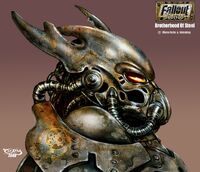
Midwestern Brotherhood power armor
| The following is based on information from Fallout Tactics. |
Midwest Brotherhood
The Midwestern branch, a splinter faction which lost contact with the Brotherhood leadership at Lost Hills has been an independent organization since the 2160s, when the airships of its founders crashed near Chicago. Unlike the original, isolationist Brotherhood, this faction rules over a large part of the area between the former states of Illinois and Kansas and drafts tribals from villages under Brotherhood protection into its ranks. While more open to the outside world, this faction of the Brotherhood is by no means altruistic - the villagers under Brotherhood rule, while protected from raiders and mutants, live in fear of the infamous Brotherhood Inquisitors. The Midwestern Brotherhood main bases were bunkers that were probably pre-Great War military bunkers that were found, taken, and rebuilt. They are called Bunker Alpha, Bunker Beta, Bunker Gamma, Bunker Delta and Bunker Epsilon. The Midwestern Brotherhood power armor is very similar to the advanced power armor Mk II, and may be a variant of it.
| End of information based on information from Fallout Tactics |
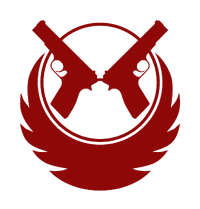
Texas expedition symbol
| The following is based on information from Fallout: Brotherhood of Steel. |
Texas Brotherhood
After the death of John Maxson, Rhombus, the head of the Brotherhood's Paladins, became the new High Elder. After the death of the Master, the Brotherhood of Steel helped the other human outposts of the Core Region drive the mutant armies away with minimal loss of life on both sides of the conflict. However, a super mutant faction under the leadership of Attis moved east and attempted to recreate the mutant army in Texas using the Secret Vault. Rhombus, despite some criticism from the ruling council of the West Coast Brotherhood of Steel, started a crusade against the still existent threat of the super mutant army, now led by Attis. They traveled eastward to Texas. There, he discovered a prototype Vault which was abandoned and installed the Brotherhood's main base of operation in this area. Their principal mission was to eradicate the menace of all super mutants. For this reason, they created a new Texas Brotherhood icon, which featured a pair of wings, topped by duel pistols, all of a red color.
| End of information based on information from Fallout: Brotherhood of Steel |
Military
The Brotherhood of Steel has characteristics similar to that of today's military such as standard armor (T-45d power armor or T-51b power armor), to standard weapons (laser rifle and the laser pistol), to standard ammunition (microfusion cells, small energy cells and electron charge packs). They also have training similar to that of recruit basic military training and trade training, have a chain of command, various bases, supply their own troops and have distinct branches/trades (i.e. Paladins and Scribes) that cover combat and support roles within the organization.
Ranks
The Brotherhood of Steel is organized into different ranks: Initiates are trainees who are expected to perform well enough in the training process to be promoted to Senior Initiates, and later to Apprentices. After proving themselves, Apprentices are promoted to the rank of Journeyman Knights or Scribes. The next rank is Knight Sergeant/Senior Scribe, Knight Captain, and finally the leader of each of these orders is the Head Knight and the Head Scribe.
Brotherhood Scribes are responsible for investigating and reverse-engineering the ancient technologies, maintaining the current technology of the Brotherhood and even experimenting with new weapons and other useful devices. Scribes rarely leave the safety of the Brotherhood's bunkers and outposts, but they are sometimes called into the field to examine a piece of technology or perform a task beyond the skills of the Brotherhood's soldiers.
Brotherhood Knights are responsible for manufacturing the weapons and other pieces of technology used by the Brotherhood, although they also take part in combat activities. After many years of service and experience, the best Knights are promoted to Paladins - the pinnacle rank of the Brotherhood military. Paladins are in charge of all security and outside activities. The Paladin ranks are Junior Paladin, Paladin, Senior Paladin, Star Paladin and Head Paladin. Paladins who survive to their later years become Elders, and they make up the Brotherhood's ruling council. Among this branch of the Brotherhood an additional rank, Sentinel, exists between Paladin and Elder. The leader of the council and the Brotherhood itself is the High Elder, usually descended from the Maxson family.
Relations with the outside
While they are generally not hostile to others without a good reason, members of the Brotherhood are not interested in justice for the obviously weaker and less fortunate wastelanders around them. They largely focus on keeping their secrecy and preserving and developing technology, which they often put above human life since technology is irreplaceable in the post-nuclear wastelands—lives are not. Their motives are often unclear, and Brotherhood members are not people to be trifled with. It is safe to say, however, that if a group of Brotherhood Paladins appears to be helping outsiders, their motives are not altruistic.
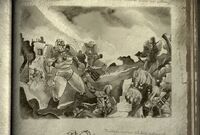
Brotherhood Paladins fighting super mutants and raiders.
The Brotherhood does not like to share their choicest technological bits with others, despite the obvious benefits their technology could bring to the Wasteland. It is a commonly accepted truth within the Brotherhood that the people of the Wasteland are not responsible enough to use (and maintain) all of the technology the BoS has at their disposal. They are known for trading some of their technologies with frontier communities and the states of the New California Republic in exchange for food and other resources, but they keep the more sensitive and advanced technologies to themselves.
Attitude towards mutants
The Brotherhood's attitude towards mutants ranges from dislike (e.g. in the case of ghouls) to outright hostility (in the case of super mutants). Early contact with the Master's super mutants was mostly hostile, and the BoS helped drive the majority of the mutant armies away from California. The Brotherhood grew angry when various salvaging operations began in the Glow, a location which the Brotherhood came to regard highly both for their fallen comrades and the pre-Great War technology located there, with Dayglow ghouls at the forefront. Most Brotherhood members came to see ghouls as filthy scavengers. In the years after the Master's defeat in the Core Region, many super mutants settled peacefully among humans and the Brotherhood was no longer hostile to them.
Technology
Military technology is the Brotherhood's main priority, and their efforts over the centuries have equipped them with a powerful array of power armor, energy weapons, defense turrets, and computers. Their devotion to the cause of collecting technology is such that they are willing to go to war in order to obtain it, even against much larger organizations such as the NCR.
Although less advanced than the Enclave, Brotherhood soldiers are generally equipped with Energy Weapons and suits of Power armor, usually either the T-51b or T-45d models, both of which were designed before the Great War. Recon armor is also widely used, primarily by scouts, knights, and initiates. In addition, the Brotherhood has access to some of the best medical technology available in the post-war world, and other technologies such as cybernetics and surgical implants.
The Brotherhood also has access to advanced computers which they have found in various military bases and Vault-Tec Vaults such as the Lost Hills bunker, the ruins of the Pentagon, Bunkers Alpha, Beta, Gamma, Hidden Valley and the Vault Prototype.
They also possess heavy duty combat robots that have assisted them in battle, like the intimidating sentry bots, and even a 40-foot Communist-hating metal giant in the hands of the Capital Wasteland detachment.
Notes
- Despite being relatively small (compared to groups such as the NCR), the Brotherhood is probably the most widely spread faction in post-war America.
- They are the only group outside of the Enclave that uses Power Armor (and that can train others to use it). Some NCR soldiers in the Mojave wasteland, however, wear non-functioning power armor.
- Most members of the Brotherhood are usually gruff in dealing with outsiders and usually extremely rude towards mutated creatures such as ghouls or super mutants.
- The Brotherhood is extremely territorial when it comes to technology and will defend any technological relic to the death.
- Despite revering ancient technology, the Brotherhood has no interest in medical technology like prosthetic organs or Auto-Docs.
- A lot of other BoS chapters such as the Midwestern and Capital Wasteland divisions changed their ideology. The Midwest BoS even recruit mutants into their chapter, the Capital Wasteland BoS recruits any wastelander into their chapter and also try to get support from them. The Mojave chapter's former elder, Elijah, also wanted to get more recruits from the outside and as such he would dispatch scribes to retrieve farming equipment and other beneficial technology, believing that the Brotherhood would be unable to survive without providing tech to the people of the wastes, gaining their favor and with it more recruits. But, his idea was not passed to his successor.
- The Brotherhood of Steel does not appear as interested in technology on the East Coast but rather seem to be more interested in trying to restore the Wasteland. Their ethical concerns that stemmed from the increase of super mutant activity and not the acquisition of new tech caused them to sever their connections with the main BoS HQ and become a faction in their own right.
- The actions of the Brotherhood of Steel on the Eastern seaboard encouraged a section of BoS knights and paladins and scribes - who still upheld the original ideology of the Brotherhood - to schism off, forming the Brotherhood Outcasts.
- As of 2281, due to the NCR-Brotherhood War, the Capital Wasteland division may be the only stable power left of the Brotherhood of Steel.
Development
The Brotherhood of Steel were based on a completely hostile faction known as the Guardians in the 1987 game Wasteland which is known to be the predecessor to Fallout.
Appearances
The Brotherhood of Steel appears in all Fallout games to date.
Gallery
References
Cleanup (Issue: This article includes a list of references, related reading or external links, but its sources remain unclear because it lacks inline citations.)
To meet Nukapedia's quality standards, this article or section may require cleanup. Please help by improving the article.
|
- ↑ Description of the symbol seen when clicking on the insignia in Fallout (PRO SCEN.MSG)
- ↑ Chris Avellone, Fallout Bible 6
- ↑ Fallout 3 Faction Profile – the Brotherhood of Steel by Emil Pagliarulo
This article is based mostly on the description of the Brotherhood from Chris Avellone's Fallout Bible #6 (which was partly based on Chris Taylor's Fallout: Warfare background), updates in subsequent issues of the Bible, and information taken from holodisks and dialogue in Fallout and Fallout 2. Some information is taken from Fallout Tactics (mostly from the intro), Van Buren, and even from Fallout: Brotherhood of Steel background, but in all instances it is marked as such.
Holodisks about the Brotherhood of Steel
Fallout
- Captain Maxson's Diary
- Maxson Log
- Ancient Brotherhood Disk
- Sophia Tape
Fallout Tactics
| |||||||||||||||||||||
| ||||||||||||||||||||||||
